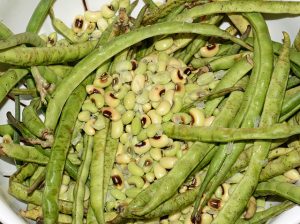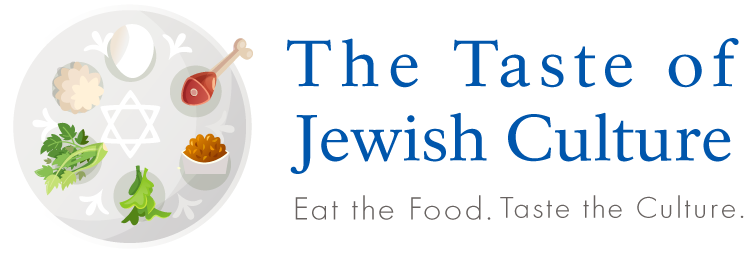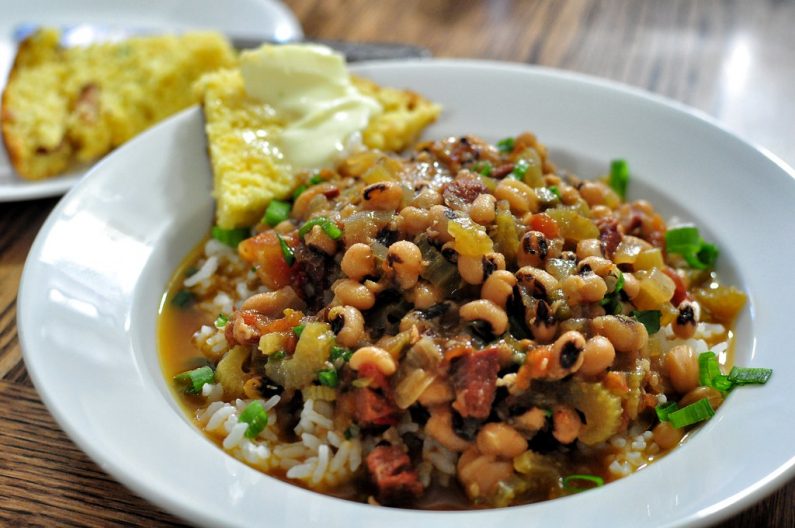One of the amazing things you uncover when you study food is the similarities between foods of different cultures. Flavors, cooking methods, symbolism and more — when similar things crop up in the cuisines of distinct cultures, they underscore how connected we all are, rather than the things that separate us. A symbolic New Years food from the American South shows one such interrelation, between the African-American and Jewish-American communities.
Hoppin’ John is a Soul Food classic, combining black-eyed peas (aka cowpeas or field peas) with pork and served over rice. The dish is believed to have originated in the Carolinas, and is traditionally eaten on New Years Day (which is why I am posting this today, right after New Years). Typically, it is seen to augur good fortune in the year ahead, but many questions surround this dish. What is the origin of the name? When was it invented and by whom? And most significantly, what makes this food symbolic of a good year ahead?
Since I specifically explore Jewish Food history and culture, I am not going to delve into the first few questions. But the answer to the last one does connect with my topic. The specific connection between this food and good fortune may stem from Judaism, and may also explain why it is commonly eaten on New Years.
A Jewish Symbolic Food
As an ancient people, Jews have an ingrained mindset of seeking meaning in otherwise mundane things. Food is one such area — a daily habit that often becomes rote and mindless. Jews typically seek to elevate the mundane and imbue everything with spirituality. So in addition to the numerous blessings we make before and after consuming any food, we also have developed an elaborate body of foods we see as having symbolism, either in general or on specific occasions. There are, for example, special foods classically eaten to celebrate a birth, or in a house of mourning. Holiday foods show this tendency even more. The Passover Seder is replete with them — matzah, bitter herbs (maror), charoset and the four cups of wine all fall into this category. Dairy foods on Shavuot and fried foods for Chanukkah also have symbolic purposes.
But no holiday features more symbolic foods than Rosh Hashanah, the Jewish New Year. As I discuss in my Food Talk “Not Just Apples and Honey: Rosh Hashana Foods and Their Many Meanings,” the numerous food items that Jews consume on the holiday show the complexity and antiquity of the Jewish nation. Many different foods are used to embody the same wishes for the year ahead. Alternatively, the same food may be used by Jews from different areas to symbolize distinct wishes for the coming year. And there are even some foods that some Jews specifically make a point of eating on the holiday while others absolutely avoid them!
Most interestingly, for this post specifically, is that numerous food items that Jews consume for their symbolic value on Rosh Hashanah are also eaten by many other peoples of the world on their New Years, or other holiday celebrations. As we will soon see, some of these cultural boundary crossers include dishes that are green, sweet things, round foods, the number seven, or even a physical resemblance to money (or actual money hidden inside a dish). As you may have guessed (or known), the black-eyed peas in Hoppin’ John is a great example of this phenomenon, connecting African-American and Jewish New Years celebrations. (It is important for me to note that there are also numerous Black Jews, and I am not trying to separate the two into purely distinct communities. I am simply using the terms here to discuss the majority in each population, which was certainly an even more exclusive description during the period from Colonial through Civil War times.)
But before I get into the details of that, I want to make something clear. I am not suggesting that Hoppin’ John is the culinary descendant of a Jewish dish. That may possibly be the case, as one of the common North African ways of preparing black-eyed peas is to stew them together with meat, much like the accompanying pork in the Black American classic. More likely, however, the two dishes share a common ancestor rather than one descending from the other.
What I am saying, however, is that the idea of eating this dish on New Years, and the specific symbolism attached to it may stem from Jewish culture. And significantly, this connection highlights something beautiful that unfortunately has been lost in recent years.
Black-eyed Peas in America

The earliest Jews to move to America, particularly in the South, were those of Sephardic descent. Having spent much time in North Africa and nearby Spain, they recognized black-eyed peas as the nutritious and tasty ingredient they are, and thus happily ate them in America as well.
Both Jews and Blacks may have eaten these peas at any time of year. But one time that Sephardic Jews always ate them was on Rosh Hashanah. As I explained in my post about the symbolic foods of our New Years, black-eyed peas had been eaten by North African Jews for nearly a thousand years to fulfill the requirement of consuming “rubia,” a food that probably was originally fenugreek, but whose meaning had been lost. Since the Arabic word for the food, lubia sounded similar, many Jews started eating it to meet the rubia requirement.
This food was not commonly eaten by Ashkenazi Jews, those who later arrived and came to dominate American Judaism. They had largely never seen or heard of black-eyed peas, and instead came to use carrots for their rubia. But the early Southern Jews would certainly have eaten black-eyed peas on that holiday. So while we have no way of knowing with certainty, one of the most plausible reasons for the Hoppin’ John/New Years connection is that Southern African-Americans saw Sephardic Jewish-Americans eating their black-eyed peas specifically on their New Years, and adopted the custom for themselves. Some of them may have even worked as cooks in Jewish households, learning the meaning behind the dish, beyond just the coincidence of food and day.
The Symbolism in This Dish
And what was that meaning?
When Jews eat rubia at their Rosh Hashanah meal (whichever version of rubia they choose), they say a blessing that it should symbolize an increase in good deeds for the year ahead. While not connected with the rubia specifically, other symbolic foods eaten on Jewish New Year are connected with money, hoping that it brings about financial success and sustenance in the year ahead. Some Jews eat green foods on the holiday, since green is symbolic of growth and development.
All of these show up in interpretations of Hoppin’ John. It generically symbolizes luck for the year ahead, but also features monetary connections. The peas are seen as mimicking coins in shape, and some have a custom to either place a penny beneath each person’s bowl, or to even hide a shiny dime in the pot, bringing even greater fortune to whoever is lucky enough to receive it in their bowl. Some put leafy greens into their Hoppin’ John, with green reflecting the color of American dollars. And a frequent accompaniment to the dish is corn bread, it yellow color reminding us of gold.
As with many of the other foods, these specific aspects also appear in the celebrations of other cultures. A Persian Haft-Sin table for Nowruz will always have green on it, while Vietnamese banh chung sticky rice cakes for their New Years are also green. Meanwhile, the jiaozi dumplings commonly eaten for Chinese New Years were most likely chosen because of their linguistic connection to early Chinese currency, and many hide coins inside of them as well.
How do such similar customs show up in the celebratory foods of such diverse cultures? Part of the answer is that no matter where we are in the world, and despite our numerous differences, people everywhere want more or less the same things. To live secure lives and be happy. Throughout the millennia of civilization’s development, the peoples of the world have met, mixed, learned from each other, and re-separated, and took influences with us. The only reason I suggest the direction of influence moving from Judaism to African-Americans in relation to Hoppin’ John is the very long time that Jews had been eating black-eyed peas for Rosh Hashanah, and the relatively newer custom of Blacks eating it on new Years day.
Most importantly, however, this connection also highlights a historical truth. For much of American history, Jews and Blacks have enjoyed good and convivial relations. This is not to deny that there were Jewish slave owners in America. But numerous studies have proven they were the minority, both in terms of percentage of slave-owners and in relative proportion to the overall Jewish population. Much more significantly, Jews helped fight against slavery and later stood side-by-side with African Americans during the civil rights movement. Both groups historically recognized the commonalities they shared. Only in recent years have those bonds begun to decline, a very unfortunate development for both communities.
Rather than one community taking from or giving to another, cuisine can often show what we share. By highlighting a common symbolic food like this, enjoyed by our two cultures, I hope that we can reinvigorate the deep connections between our people.






